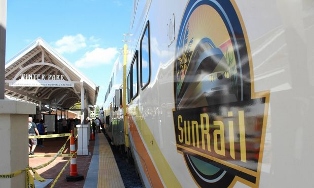|
SunRail Challenge: Changing the Psychology of Commuters  May 2nd, 2014 | WMFE, Orlando - The first phase of SunRail is officially underway, but with many Central Floridians accustomed to using their own cars for all their transportation needs, SunRail faces a fundamental question: how do you convince people to give up their driving habit in favor of mass transit? Experts say it's no small feat to entice Central Florida away from its "car-centric" culture in a lasting manner. [Winter Park SunRail Station. Photo Credit: Carmel Delshad, WMFE] "If you build it, they will come" may have worked in the film Field of Dreams, but fulfilling the vision of successful mass transit in Central Florida isn’t so simple. While some area residents are already "on board" with SunRail, so to speak, Rollins College marketing and ethics professor Mark Johnston says the first order of business is changing the minds of the driving majority. "There’s a psychological barrier because people are used to getting in their car, they’re used to driving," explains Johnston. "So, from SunRail’s perspective, one of the things they have to do is break through the barrier of driving, and convince people that there’s a reason they should try using SunRail." So, how does SunRail rewrite the way Central Florida thinks about mass transit? Johnston says step one is confronting the most common concerns of potential riders, "things like convenience, or the timing of the trains, cost perhaps," he says. "Identify where the pain points are for consumers and then create messaging that essentially addresses that." For example, SunRail's advertising already emphasizes that the train is easy to use. Johnston says another way in may be to point out that riders won’t have to hunt for parking – or pay for it – once they’ve reached their destination. He gives SunRail an “A” for its messaging so far, but he cautions that changing the minds and long-time habits of the region is going to take time. Rollins environmental studies professor and urban planner Bruce Stephenson agrees. Stephenson served on the Winter Park Rail Commission, which approved the city’s SunRail station after two years of study. He says it’s going to take longer than that for the train to get fully integrated into Central Florida. “Just like our roads and highway system took years – look how long it took us to complete the interstate – we’re going to have to look at transit in the same way,” says Stephenson. "I think you have to look at rail in a ten-year time frame, not just one or two years.” So, not only will it take time for the message of SunRail to penetrate, explains Stephenson, it will also be some years before all the proposed routes are complete. And there does seem to be some confusion about the purpose and the routes of SunRail’s first phase. When 90.7 News asked some Rollins students if they were planning on riding SunRail, a few said they would ride the train to get to Miami, go to the beach, or to get home safely after a late night. For the record, SunRail runs roughly parallel to I-4 between DeBary and Sand Lake Road, with a schedule geared toward the Monday-through-Friday commuter crowd. It doesn't go to Miami or the coasts, and it doesn’t run late at night or on weekends... ...or at least, not yet, Stephenson points out. But there plans have been drawn up for a complete system tying ifferent types of transportation together, and Stephenson thinks that’s what will really fill SunRail’s seats. “To me, the key is getting the rail eventually to the airport,” he says. “Once it gets to the airport, the system will function, it will become like other highly developed cities.” Also, Stephenson says, it’ll be cheap – and once people have experienced that efficient ride to the airport for two bucks instead of a thirty dollar cab ride, they’ll be hooked. In order to grow that much in the future, though, Mark Johnston says SunRail is going to have to bring its “A” game now, because if people do try the train and don’t like it, odds are they won’t give it a second chance. “At the end of the day, it’s going to be getting people to try it, delivering a good experience to them, and then continuously updating that with the advantages of it, so that over time people’s actual perspective of mass transit will change,” says Johnston. |
|
|